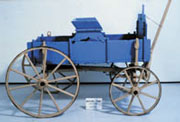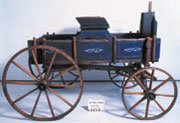
 |
||
 |
||
 |
Conservation of an Object: A Child's Wagon from A. D. 1900 |
||||

Some Objects Need Cleaning, Repair, or Restoration Sometimes the Museum receives an object that would be an excellent exhibit if it were only in better condition. This happened in 1976, when a donor gave the Museum a child's toy wagon made about 1900 A.D. The wagon was a good example of a child's toy from one hundred years ago, but the last owners had painted it blue and tan, covering up the original paint and decoration. The new paint made it difficult for the curator to answer these questions:
The curator wanted to undo the recent changes and return the wagon to its appearance in 1900 for the exhibit. Conservation requires specialized knowledge of chemistry and technology. For a curator to conserve the wagon without damaging it, she or he would need to know:
Conservators study and train for many years to become knowledgeable of the science of conservation. With this in mind, the curator took the wagon to a conservator's laboratory in St. Louis. There the conservator examined and tested it and gave the curator a report describing the:
To make this report, the conservator had to find out what was under the new paint. The conservator cut a tiny sample of the wagon's paint that included all of the layers down to the wood. Using a microscope, he looked at the sample in natural light and then in ultraviolet light. The ultraviolet light helped the conservator determine what kinds of paint and other materials had been used on the wagon:
Next, the conservator wanted to remove some of the new paint to see what was underneath. Because the paint sample indicated that the original paint was oil-based, the conservator decided to use a water-based paint remover that would strip away the modern paint but leave the old paint.
After treatment. Restoration Decisions Something
to think about:
or
To answer this question, think about where the wagon was probaably kept a long time ago (indoors or outdoors) and how it was used over many years. The conservator had two choices: he could leave the seat alone or repaint it. Which choice would leave us with the most information about how children used the wagon?
After
conservation the wagon looks almost like it did when children played
with it in 1900. It has the original designs and colors. Notice
whether or not the seat is paintedónow you know what the conservator
decided! The restored wagon is now on display in the Museum's At
Home in the Heartland exhibit.
|
||||
|
|
Copyright© 2000 Illinois State Museum Society

 By
shining a bright light sideways across the wagon's sides and panels,
the conservator saw the shadows of a fancy decoration, like a decal,
under the paint. So, he carefully removed the paint from a small
spot on one panel. He could now see the stenciled designs clearly.
They had been made with metallic paint in resin (the third layer
he saw in the paint sample).
By
shining a bright light sideways across the wagon's sides and panels,
the conservator saw the shadows of a fancy decoration, like a decal,
under the paint. So, he carefully removed the paint from a small
spot on one panel. He could now see the stenciled designs clearly.
They had been made with metallic paint in resin (the third layer
he saw in the paint sample).

 After
the new paint was removed, the wagon's seat had only a little original
paint left on it. If the conservator usedthe same materials and
techniques on the seat as on the rest of the wagon parts, why was
most of the original paint on the seat missing?
After
the new paint was removed, the wagon's seat had only a little original
paint left on it. If the conservator usedthe same materials and
techniques on the seat as on the rest of the wagon parts, why was
most of the original paint on the seat missing?
